Technologies
Apple Watch Series 9 Review: New Tricks Make for a Minor Upgrade
With Double Tap and a faster Siri, the Apple Watch Series 9 is slightly easier to use. But it otherwise has a lot in common with the Series 8.
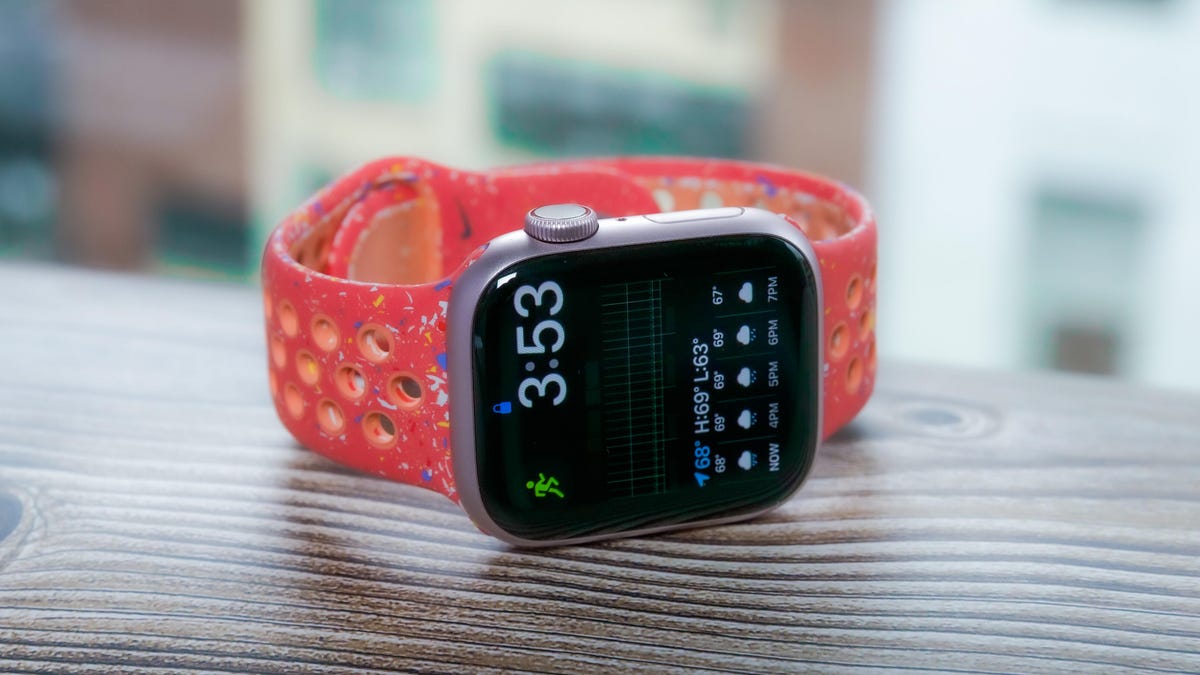
When it comes to the new Apple Watch Series 9, which starts at $399 (£399, AU$649) and is available now alongside the Apple Watch Ultra 2, it’s what’s on the inside that counts. That’s my biggest takeaway after spending a few days with the Series 9, which has an upgraded chip that powers faster Siri performance and new gesture controls called Double Tap.
It’s these additions that separate the Series 9 from last year’s Series 8, and they make the Apple Watch more convenient to use. But they’re not monumental enough to convince recent buyers to upgrade.
My time with the Series 9 so far suggests that new features like Double Tap may not show their usefulness right away. However, they could become helpful in the long run.
Double Tap takes some getting used to, and it’s not compelling enough on its own to justify buying the Series 9. But I’d be lying if I said I didn’t find myself using it to dismiss a notification and easily navigate back to my watch face here and there. (The version of Double Tap I tested was a preview, which I accessed on a separate review unit running an early software build of the feature.)
Siri’s most appealing update, the ability to answer health-related questions now that it can process data locally instead of in the cloud, isn’t coming until later this year. Yet if it works as promised, it could make the Series 9 a much more useful health tracker.
The Series 9 doesn’t have everything on my wish list. For example, I was hoping for longer battery life and the Apple Watch Ultra’s Action button. But as is the case with the iPhone 15, it will be a solid upgrade for those with an older model. That’s especially true for frequent Siri users and those who primarily use their Apple Watch for exercise and wellness tracking.
Apple Watch Series 9’s new Double Tap gesture
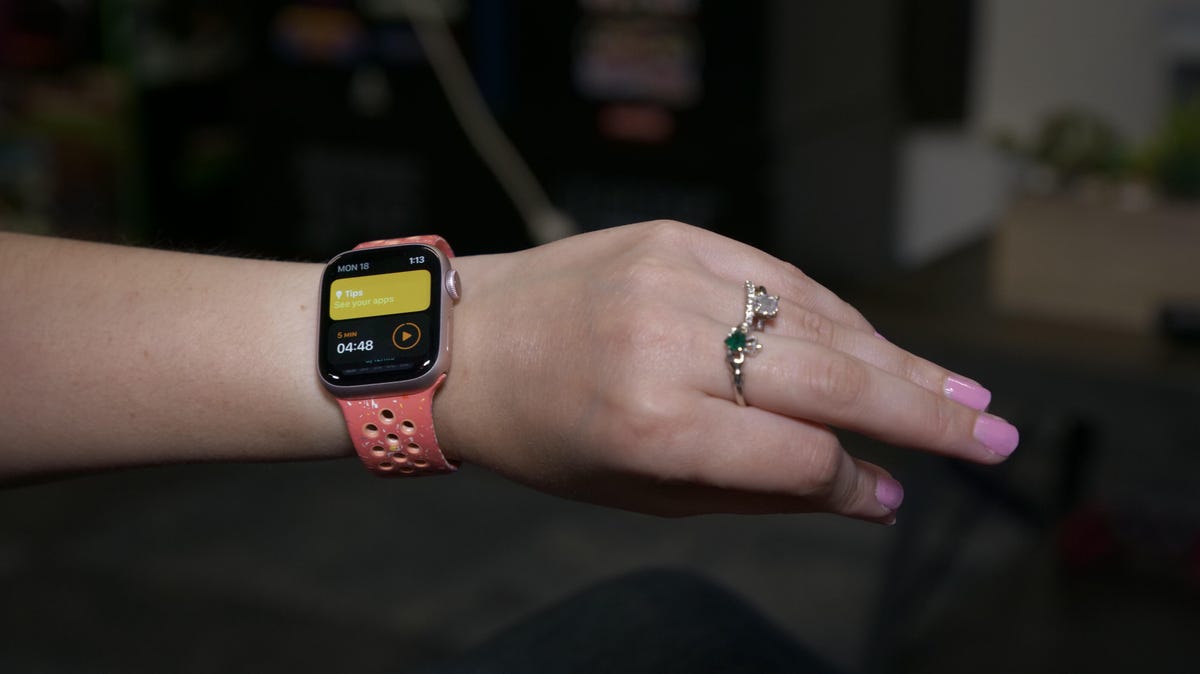
Apple rarely adds new gestures to the Apple Watch, so I was eager to try Double Tap. Just as the name implies, you trigger this feature by tapping your index finger and thumb together twice. Doing so allows you to dismiss a notification, pause your timer or access widgets from the watch face, among other actions. It’s programmed to perform whatever the primary action in a notification is, whether that be casting aside your standard reminder or replying to a text message.
The Apple Watch already supported a similar gesture through its AssistiveTouch accessibility mode. But Double Tap is baked into the Series 9’s user interface across the board, and its chip enables the watch to support this feature all day without impacting battery life. The pinching feature that’s included as part of the watch’s accessibility options, meanwhile, is meant to be customized based on a person’s needs.
Double Tap has a bit of a learning curve, but that could be because I’m using an early version of it. I most frequently use Double Tap to dismiss notifications, stop timers and send text messages hands-free. This was particularly useful while brushing my teeth before bed, since I like to check the time and my exercise progress before hitting the sack. When a notification was blocking my watch face, I pinched my fingers together to dismiss it without having to put down my toothbrush.
It’s a simple use case, but one that highlights the promise behind Double Tap. Being able to dictate a response to a text message without touching the watch could also be useful in situations when my hands are full, such as when I’m cleaning, cooking or even gripping the subway pole during my commute to work.
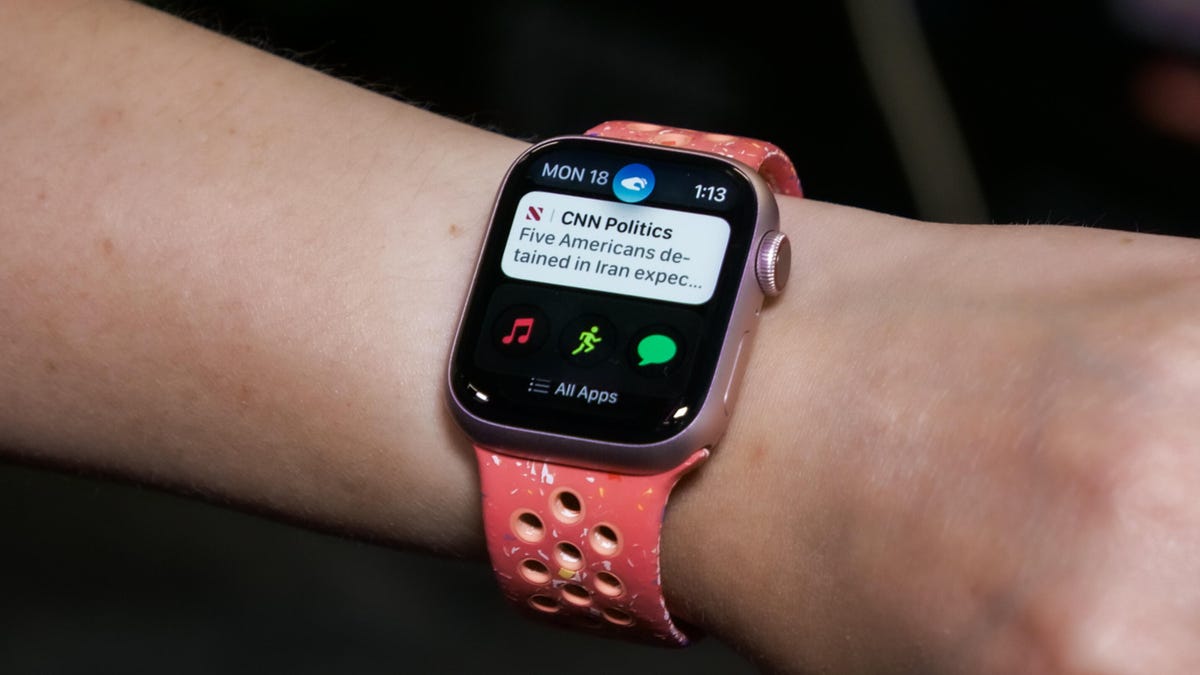
My biggest issue with Double Tap, however, is that it just doesn’t feel intuitive yet. We’ve been conditioned to tap, swipe and speak to our devices over the last two decades. Even though Double Tap came in handy during that one instance while I was brushing my teeth, my instinct usually tells me to tap my watch’s screen. It’s going to take time to break that habit.
Double tapping can also look awkward to those who aren’t familiar with it. When I tested the Apple Watch Series 9 over the weekend, a friend began giving me strange looks when I started pinching the air with my fingers.
Double Tap doesn’t feel as game-changing as other user experience-related updates the Apple Watch has received over the years, like the Series 5’s always-on display. But who knows — maybe it’ll start to feel natural. After all, everyone thought AirPods looked goofy at first, but now they’re everywhere. Double Tap doesn’t feel like a reason to upgrade, but we’ll know more when the feature fully launches.
Siri gets a speed boost on the Series 9
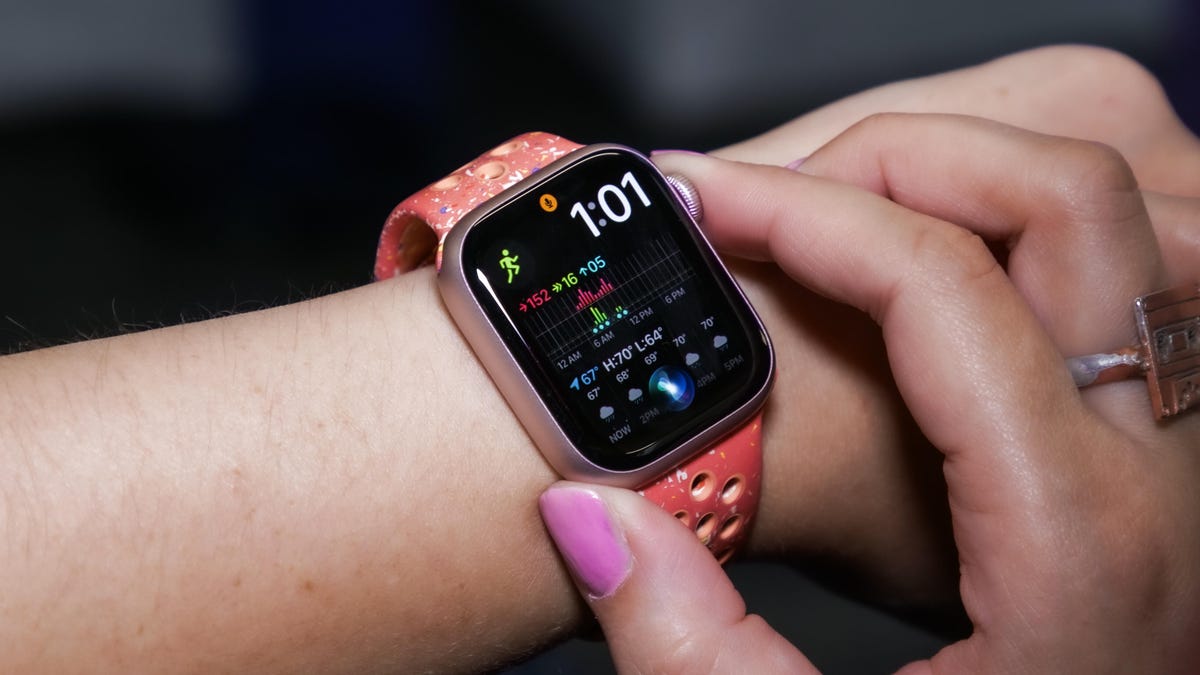
Another benefit from the Series 9’s new S9 processor is a faster Siri experience. Siri can now answer requests slightly faster for two reasons. First, certain queries that Siri doesn’t need to rely on the internet to answer, like setting alarms or timers, now happen on the watch. Dictation is also supposed to be up to 25 percent more accurate, which should mean Siri understands you correctly the first time.
Coming from the Series 8, I noticed a difference. I use Siri daily for setting alarms and timers, especially when I’m stretching before a workout. I often repeat myself when using my Series 8 or the Series 6 I bought roughly three years ago. That hasn’t happened as much on the Series 9 so far.
I also timed how long it took for Siri to respond to certain questions on the Series 9 compared to the Series 8. For this test, I only asked questions that Siri could answer without plucking an answer from the web. Siri was faster on the Series 9 in almost every scenario, as you can see in the table below.
Series 9 vs. Series 8: Siri response times
| Series 9 (in seconds) | Series 8 (in seconds) | |
|---|---|---|
| «Set a timer for 5 minutes» | 1.73 | 2.52 |
| «Cancel my timer» | 1.66 | 1.74 |
| «Set an alarm for 9 a.m.» | 1.81 | 1.93 |
| «Start an outdoor walk» | 3.39 | 3.32 |
| «Stop my workout» | 2.33 | 3.06 |
| «Cancel my alarm» | 1.94 | 2.2 |
Siri will soon be able to answer health-related queries, which should make it easier to quickly parse all the activity and health metrics your watch gathers throughout the day and night. But it won’t be launching until later this year.
I’ve been waiting for a feature like this because finding what I’m looking for in Apple’s Health app isn’t always intuitive. Manually logging activity data and finding specific metrics, like exercise minutes for the past week, can take a couple of taps. Using Siri should hopefully make queries like these much faster and more convenient.
It’s also nice to see Siri playing a larger role on the Apple Watch. Smartwatches aren’t ideal for long touchscreen interactions given their small size, so they present an opportunity for voice assistants like Siri to shine.
Apple Watch Series 9 is better at finding your iPhone
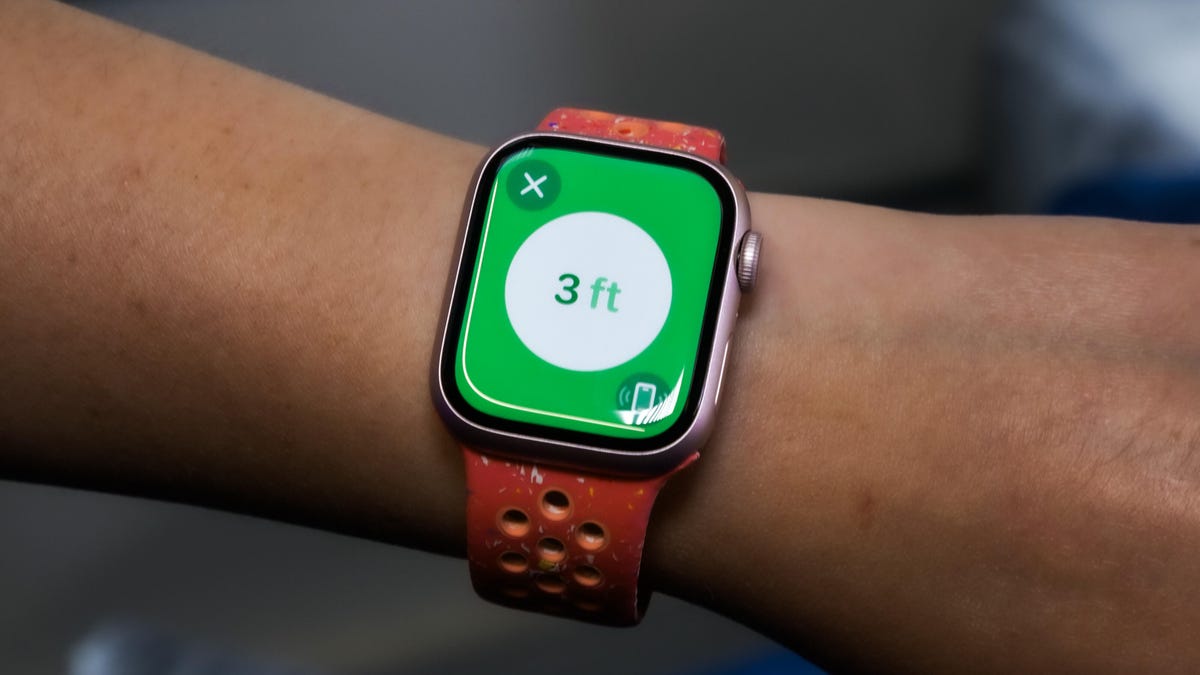
If you’re anything like me, the Apple Watch has been a godsend for tracking down your misplaced iPhone when it slips between the couch cushions. Apple made the watch an even more useful iPhone locator, thanks to the second-generation ultra-wideband chip inside. Not only can you ping your iPhone, but the Series 9 will show an estimate of how far away you are from your phone, along with a nudge in the right direction.
The catch, however, is that this feature only works if you have an iPhone 15 or iPhone 15 Pro, since those are the only Apple phones to also have the new ultra-wideband chip. That means unless you plan to buy a new iPhone along with your Apple Watch, you won’t be able to use it.
To put the Apple Watch’s new Precision Finding feature to the test, I had a friend of mine hide my iPhone 15 in my apartment while I waited in another room. He chose a difficult hiding spot; tucked underneath my living room carpet, a place where my phone is never likely to end up, even by accident. But the Apple Watch pointed me to the exact corner where my phone was hidden almost immediately, and I was able to track it down in less than five minutes.
To be fair, the audible chime that my iPhone emitted when being pinged by my Apple Watch also played a big role in helping me find it. That feature is already available on existing Apple Watches and iPhones. But being able to see how many feet away I was from my phone added an extra layer of confidence that I was looking in the right direction. This could be helpful if I lost my phone in a noisy environment like a restaurant.
The new chip also brings tighter HomePod integration, allowing you to see media suggestions at the top of your watch’s widget stack when you’re within 4 meters of the device. While these new features are limited to those who own the iPhone 15 or a HomePod, I’m glad to see Apple finding new ways to put ultra-wideband to use. It’s something I’ve been hoping to see in future Apple Watches, as I wrote back in 2022.
Same health and wellness as the Series 8
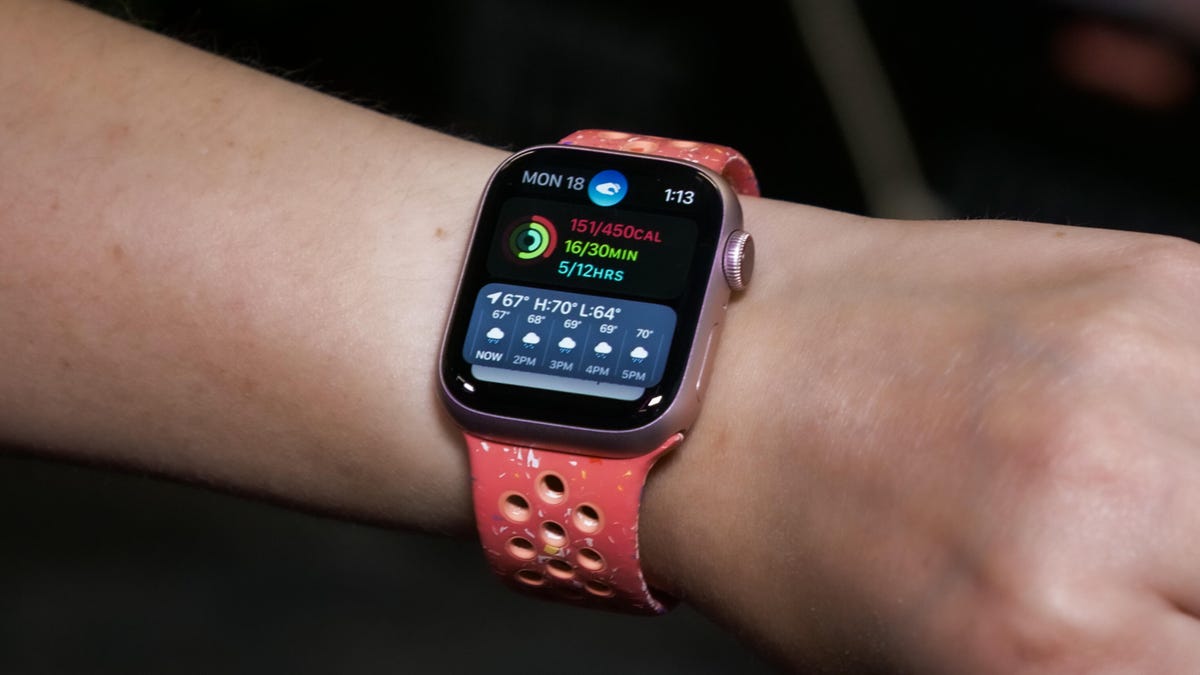
The Series 9 inherits the same health and safety features as the Series 8. That includes the ability to take an ECG, temperature sensing, blood-oxygen detection, high and low heart-rate notifications, irregular heart rhythm notifications, sleep stage tracking, fall detection and crash detection. It’s also rated for the same degree of dust and water resistance as last year’s Series 8.
The Apple Watch’s broad selection of health metrics is exactly what you might expect of a smartwatch at this price, and it’s likely more data than most people need. But I’m still waiting for more features aimed at rest and recovery, a key area where other wellness and sports devices from brands like Oura, Fitbit, Garmin and Whoop excel over Apple. These gadgets can analyze bodily markers and activity trends to assess how well rested you are, which can be easier to decide whether it’s time for a workout or a rest day. However, Apple doesn’t charge a subscription fee to access all health insights, unlike Fitbit, Oura and Whoop, which require memberships to get the full experience.
No Action button and the same battery life as Series 8
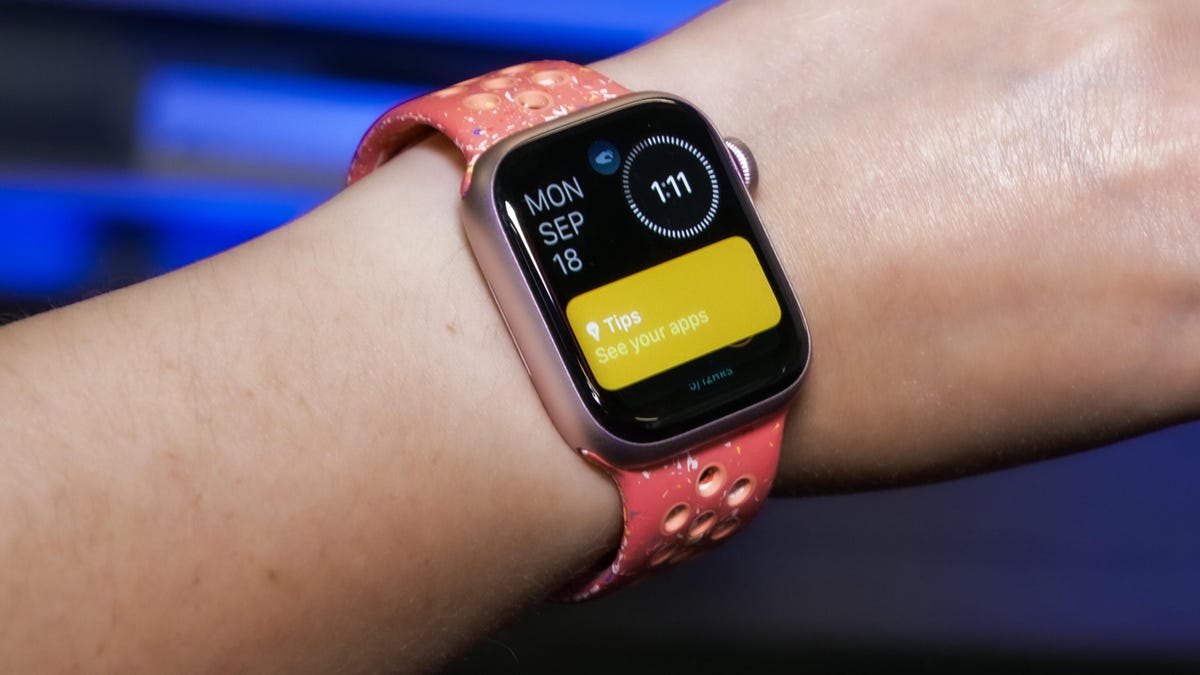
The Series 9’s theme is seemingly focused on convenience rather than new health features. That’s why I was hoping the Series 9 would gain the Apple Watch Ultra’s Action button, a programmable key that lets you perform tasks like starting a workout or a stopwatch with just a tap.
While keeping certain features exclusive to the Ultra line is understandable given its higher price, the Action button feels like it should be part of the broader Apple Watch experience. The Ultra already has plenty of other features to distinguish it from the Series 9 and SE, including a bigger and brighter screen, longer battery life, a more durable design and a depth gauge, among other extras. The Action button would have fit nicely with the Series 9’s other upgrades aimed at helping you navigate the watch more easily.
The Series 9 has an always-on display, just like every flagship watch model since the Series 5, which is a key feature that separates it from the less expensive $249 Apple Watch SE. While the overall design is the same, Apple reduced its carbon footprint to make the Series 9 paired with a Sport Loop band the company’s first carbon neutral product.
It’s also rated for the same 18-hour battery life as the Series 8, which means it should last for one to 1.5 days on a single charge, depending on how you’re using it. On one hand, that’s impressive considering the Series 9 has a brighter screen and a more powerful processor.
But I wouldn’t mind sacrificing some of these new features, like a brighter screen or faster Siri, if it meant having longer battery life. I often find myself choosing between wearing my Apple Watch to sleep or leaving it on the charger overnight so that it’s ready to log my morning walk and afternoon workout. Having a battery that lasts for more than a day and a half means I wouldn’t have to make that decision.
Since I’ve been switching between my main Series 9 review unit and a separate unit with an early version of Double Tap, I haven’t been able to get a solid sense of the Apple Watch’s battery life. But I’ll update this review accordingly with more details.
Apple Watch Series 9: Final thoughts
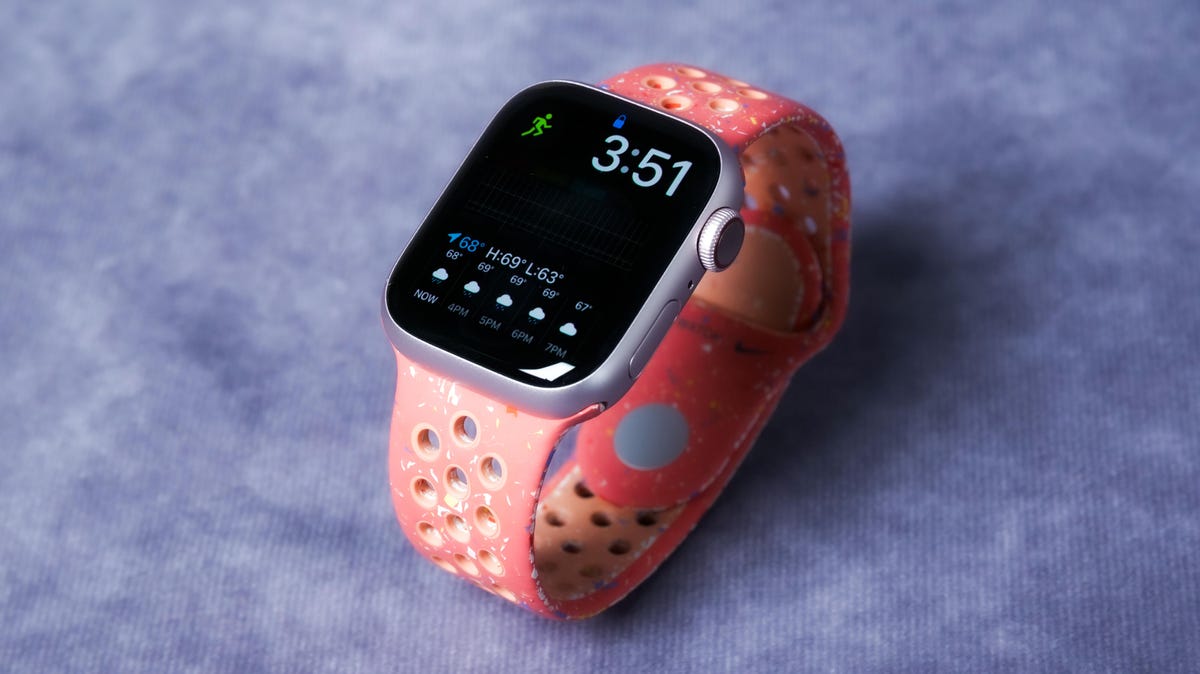
The Series 9 feels like a minor upgrade over the Series 8. New features like Precision Finding and faster Siri performance make the Series 9 a better smartphone companion. But it’s not worth it unless you’re a first-time buyer or have the Series 6 or earlier.
Coming from an older watch like the Series 6, you’ll have plenty to gain. In addition to what’s new on this year’s model, you benefit from a larger screen with a keyboard, a temperature sensor and noticeably faster performance compared to a 3-year-old watch. If you have an Apple Watch SE and are craving more health metrics, the Series 9 is also a worthwhile upgrade.
Like many recent Apple Watch updates, such as the Series 8’s temperature sensor, there’s potential for the Series 9’s new features to evolve and become more helpful over time. It signals a promising direction for the Apple Watch, aligning with the tick-tock pattern Apple has seemingly followed over the last several years. Apple typically alternates between bringing new health sensors to the watch and launching updates related to convenience and the general user experience. This year happens to be the latter.
But right now, the Series 9 feels like a refreshed version of the Series 8 rather than an entirely new generation.
Technologies
Can Chemicals Turn My Orange iPhone 17 Pink? Here’s What I Found Out
There are reports that some cosmic orange iPhone 17 Pro handsets are turning pink. I threw chemicals at my iPhone to see what would happen.
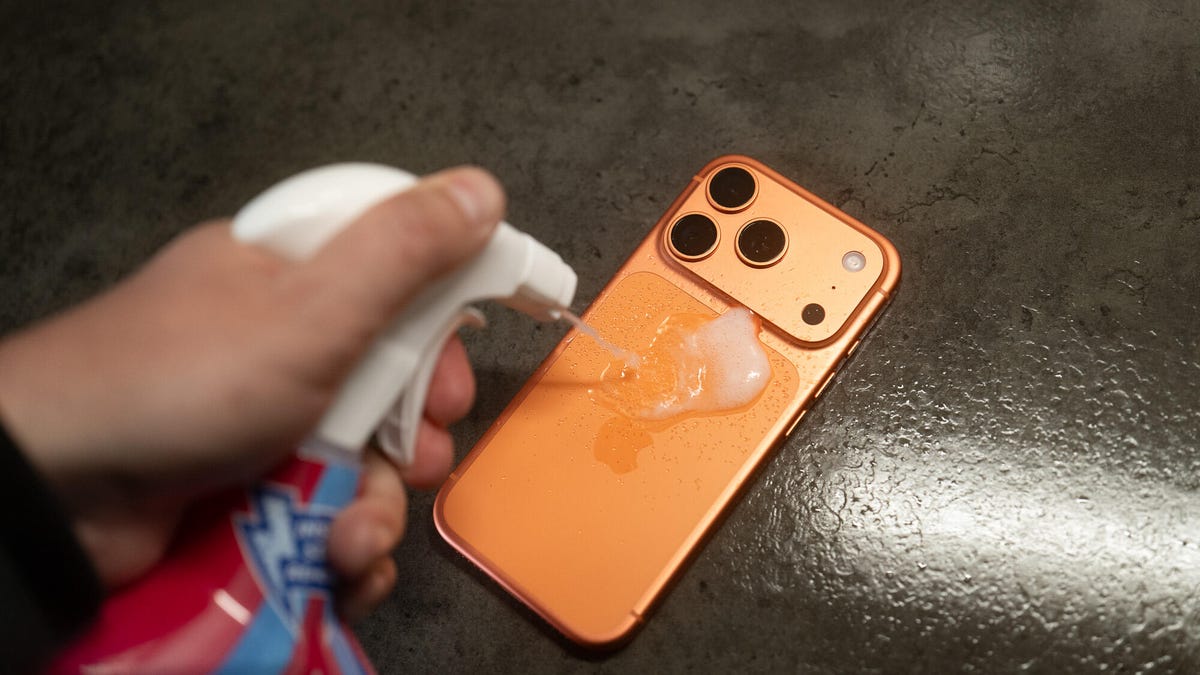
A recent Reddit thread suggests that it’s possible for a cosmic orange iPhone 17 Pro to turn vibrant pink. As PCMag’s Eric Zeman noted, it’s likely that the phone has been discolored by cleaning substances that affected the finish, turning it from vibrant orange to a wild hot pink. Sure, this might technically be a fault, but in all honesty I love pink phones and the idea of a hot pink iPhone 17 Pro filled me with joy. So I wanted to see if I could test the theory and see just what color-changing effects various household cleaners might have on my phone.
It’s important to note here that the iPhone 17 Pro I used was bought by CNET for the purposes of testing. Had I paid over $1,000 of my own money I wouldn’t be so reckless in smearing it with chemicals that could potentially irreparably harm it. And you shouldn’t either. If you need to clean your phone, do it safely. Disclaimer aside, let’s dive in.
The chemicals
I bought two chemicals to test this out. Zeman explains that it may be oxidation that caused the color to change and that hydrogen peroxide could do this. I couldn’t find this over the counter in the UK, so I instead bought an «oxy-active» stain remover spray that, among other things, contains «oxygen-based bleaching agents» which sounded ideal. Apple also clearly states «don’t use products containing bleach or hydrogen peroxide» on its support page so, naturally, I bought some thick bleach too.
Oxy application
I started by spraying the oxy cleaner on a microfiber cloth until it was noticeably wet from the liquid and then liberally applied this all over the rear of the iPhone. The Reddit user with the affected phone showed that it only affected the metal parts, not the glass back panel, so I made sure to focus my attention on the sides and camera bar.
With the phone well and truly doused in chemicals that have no business being anywhere near a phone, I left it to sit and think about what it had done for 30 minutes — after which time I wiped it dry and took a close inspection. Disappointingly, my phone was still factory orange, rather than «what the hell have you done to your phone» pink. Time to move on.
Bleach blast
I opened the bleach and trying hard not to think about my days as a middle school cleaner, applied a liberal blob of the stuff to a cloth and smeared it over the defenceless phone, concentrating again on the metal areas. I definitely should have worn protective gloves for all of this so please make sure you take better care of yourself than I do if you do anything with bleach.
Again, I gave it a 30-minute settling in period before cleaning it off and inspecting the results.
The phone remained as orange as ever, looking as box fresh as it was the day before when it was, indeed, box fresh. The orange color hadn’t changed and now almost 24 hours later there’s still no sign of discoloration of any kind.
Is the pink iPhone 17 real?
I can’t say with any certainty whether the Reddit user’s images of a pink iPhone 17 Pro are real or not. The cuddly human side of me wants to take them at their word, while the journalist in me is sceptical. What I can say with certainty is that putting your orange iPhone into close contact with household cleaning products isn’t going to win you a funky, ultra-rare pink hue that you could sell on eBay for a small fortune.
It’s possible that using pure peroxide could be the thing that does it, but to be honest, if you’re going out of your way to throw industrial-grade chemicals at your phone then you may as well just directly try and dye it. My goal here was to see how susceptible the orange model is to everyday household cleaners such as kitchen cleaner or bathroom bleach — the sort of things it might naturally come into contact with in routine use. And what I’ve found is that, no, it won’t ruin the nice orange color. But it’s probably still not good for your phone.
Technologies
My Teen Loves Her Apple AirPods Pro 2 and You Will Too With This $100 Off Deal for Black Friday
Apple’s AirPods Pro 2 have everything you could want from a pair of wireless earbuds, plus a steep discount.

Black Friday deals: The Apple AirPods Pro 2 are some of the best personal audio gear on the market, even if they aren’t the latest model anymore. Sure, Apple’s AirPods Pro 3 are the newest earbuds in the lineup but the AirPods Pro 2 are still an excellent pick for most people.
They’re an even better buy this week during early Black Friday sales when you can get your hands on a pair of Apple AirPods Pro 2 at a discount. Right now, Walmart is shaving a massive $100 off the AirPods Pro 2, dropping the cost to $139. That’s one of the lowest prices we’ve seen — but we doubt this deal will stick around for long.
Don’t miss any of our unbiased tech content and lab-based reviews. Add CNET as a preferred Google source.
HEADPHONE DEALS OF THE WEEK
-
$248 (save $152)
-
$298 (save $131)
-
$170 (save $180)
-
$250 (save $200)
CNET’s key takeaways
- You can get these amazing earbuds for just $139 right now at Walmart.
- My teenager loves everything about them.
- The sound quality is exceptional.
- The noise cancellation can help give you some peace, even in a busy home.
My 13-year-old daughter loves her music and her privacy, and for years she has wanted a pair of AirPods. They’re not cheap so I’ve only been getting her more budget options, like the Amazon Echo Buds, as a result. These kept seemingly disappearing, though, so I finally ponied up for the AirPods Pro 2.
I picked them up during last year’s sales, and they were definitely well-received. She’s happy, she uses them every day, and she hasn’t lost them yet. The AirPods Pro 2 are currently on sale at Walmart for $139, a nice price for a high-quality pair like these, and one of the lowest we’ve seen.
What about the AirPods Pro 3?
The AirPods Pro 3 weren’t available at the time I bought the AirPods Pro 2, but they were rumored, and I didn’t wait to see what they offered. As CNET’s resident headphone expert, David Carnoy summarized in his AirPods Pro 3 and Pro 3 comparison, the newer model is «significantly improved in the four most important areas: fit, sound quality, noise cancellation and battery life.» They also have heart-rate monitoring, like the Beats Powerbeats Pro 2.
Hey, did you know? CNET Deals texts are free, easy and save you money.
While these are undoubtedly all important things, a lot of people aren’t going to notice the differences or make the most of the new features. With the AirPods Pro 3 being newer, they’re on a smaller sale and are currently available at Amazon for $220, which is $30 off the list price.
Why I didn’t get the AirPods 4 instead
Why did I choose AirPods Pro 2 instead of the AirPods 4 with ANC? First, as I mentioned in another article about a different pair of earbuds I bought, I think sealed, in-ear buds are better than open-design models like the AirPods 4. The seal creates another layer of noise isolation and contributes to superior sound quality, and if you want to pay attention to the world you can always engage ambient sound mode, which Apple calls transparency mode.
Also a factor was that, at the time, Carnoy considered the Pro 2 the best Apple noise-canceling wireless earbuds: «While we’re quite impressed with those new models — and with the AirPods 4 ANC in particular — the AirPods Pro 2 remain arguably the best Apple AirPods you can buy if you don’t mind having silicone ear tips jammed in your ears,» he said.
My daughter uses earplugs all the time to help her sleep, so she definitely qualifies as somebody who’s comfortable stuffing things in her ears. Like her fingers, when I start using words like «sigma,» «skibidi» and «relatable» to try to relate to her.
I asked Carnoy about the Pro 2s potentially not fitting in her kid-size ears and he reassured me that the range of eartips that come with the Pro 2s «now include XS, so they should fit.»
Do AirPods make a great gift?
It took me years to finally understand, but yes, for someone looking for wireless earbuds, AirPods — especially the Apple AirPods Pro 2 — make the perfect gift, regardless of whether you’re a teenage girl.
Join Our Daily Deals Text Group!
Get hand-picked deals from CNET shopping experts straight to your phone.
By signing up, you confirm you are 16+ and agree to receive recurring marketing messages at the phone number provided. Consent is not a condition of purchase. Reply STOP to unsubscribe. Msg & data rates may apply. View our Privacy Policy and Terms of Use.
Technologies
If You’re Flying for the Holidays, This Bluetooth Dongle Transforms In-Flight Movies, and It’s 35% Off for Black Friday
Watch airplane movies just like you would at home with this game-changing device.

Air travel for the holidays can be stressful, especially when winter weather or flight delays force a change of plans, but one perk of flying still remains — watching new-release movies. However, in-flight entertainment on most airlines usually requires a wired set of earbuds. (And the ones the airline hands out are so bad they may as well not even be connected.)
I’d far prefer to use my wireless, noise-canceling AirPods Pro, but they connect only via Bluetooth. There’s a simple tech solution that makes viewing movies on the plane feel more like watching them on your couch.
The AirFly is a simple Bluetooth dongle that allows me to connect my wireless earbuds directly to the airplane’s entertainment system, eliminating the need for adapters or wired workarounds.
It’s become a must-pack item in my travel bag. Since I started using it, I’ve stopped dreading in-flight audio and finally get to enjoy movies on the plane. If you fly often, this little gadget could completely change how you travel. And the base level AirFly SE is 35% off for Black Friday at Amazon.
The AirFly Pro lets me enjoy in-flight entertainment
The AirFly Pro from Twelve South is a minimally designed dongle that allows me to connect to the 3.5mm headphone jack in my airplane seat, enabling me to listen to in-flight entertainment on my noise-canceling earbuds.
All I have to do is pair the AirFly with the Bluetooth headphones I’m using, such as my AirPods Pro, plug the AirFly into the display in front of me, and I’m all set. I don’t even need to use my phone to connect the two devices.
There are several versions of the AirFly: the AirFly SE, which is currently on sale for $26 on Amazon and connects to just one set of headphones, the AirFly Pro at $55, the Pro V2 at $60 and the Pro 2 Deluxe at $70, which comes with an international headphone adapter and a suede travel case.
Hey, did you know? CNET Deals texts are free, easy and save you money.
I use the AirFly Pro, which has been a game-changer for me on flights. I’ve never had to worry about battery life since the AirFly Pro lasts for over 25 hours and can be fully charged in just three hours. I can also pair two separate pairs of headphones to a single AirFly Pro, in case I’m with someone else on a flight and want to watch the same movie or show.
And if that’s not enough, the AirFly Pro also doubles as an audio transmitter, allowing me to turn any speaker with a headphone jack, such as my old car stereo, into a Bluetooth speaker.
The AirFly Pro makes a great gift for any traveler
The AirFly Pro is the perfect present to give to someone who’s planning to travel this year. Besides my Anker MagSafe battery pack, the AirFly Pro has become my most treasured travel accessory when I fly, which is why I consider it one of those can’t-go-wrong gifts.
For more travel gear, here are our favorite tech essentials to travel with and our favorite travel pillows.
Join Our Daily Deals Text Group!
Get hand-picked deals from CNET shopping experts straight to your phone.
By signing up, you confirm you are 16+ and agree to receive recurring marketing messages at the phone number provided. Consent is not a condition of purchase. Reply STOP to unsubscribe. Msg & data rates may apply. View our Privacy Policy and Terms of Use.
-

 Technologies3 года ago
Technologies3 года agoTech Companies Need to Be Held Accountable for Security, Experts Say
-

 Technologies3 года ago
Technologies3 года agoBest Handheld Game Console in 2023
-

 Technologies3 года ago
Technologies3 года agoTighten Up Your VR Game With the Best Head Straps for Quest 2
-

 Technologies4 года ago
Technologies4 года agoBlack Friday 2021: The best deals on TVs, headphones, kitchenware, and more
-

 Technologies4 года ago
Technologies4 года agoVerum, Wickr and Threema: next generation secured messengers
-

 Technologies4 года ago
Technologies4 года agoGoogle to require vaccinations as Silicon Valley rethinks return-to-office policies
-

 Technologies4 года ago
Technologies4 года agoOlivia Harlan Dekker for Verum Messenger
-

 Technologies4 года ago
Technologies4 года agoiPhone 13 event: How to watch Apple’s big announcement tomorrow
